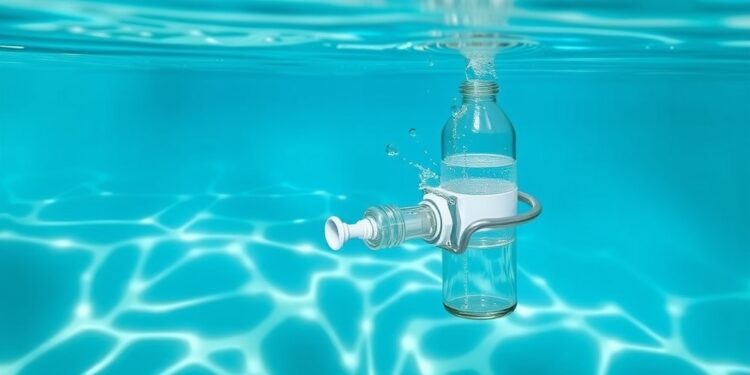
A groundbreaking advancement in the field of water desalination is on the horizon, as engineers at the University of Michigan and Rice University have introduced a novel method using carbon cloth electrodes to address a critical challenge in converting seawater into potable water: the removal of boron. Boron, a naturally occurring element in seawater, poses significant toxicity risks when it infiltrates water supplies destined for human consumption. Conventional reverse osmosis processes frequently fall short in effectively filtering boron, leading to heightened operational costs for desalination facilities. The newly developed carbon cloth electrodes offer a promising solution, with the potential to streamline operations and enhance the quality of treated water.
Boron concentration in seawater stands at approximately twice the levels deemed acceptable by the World Health Organization, which has set conservative limits for water safety. This natural contaminant can compromise not only human health but also agricultural productivity, as many crops exhibit tolerance levels significantly lower than those found in seawater. Addressing this issue has been a persistent challenge faced by desalination plants globally, which often resort to costly chemical additives and multiple treatment stages to ensure compliance with safe drinking water standards. The introduction of the carbon cloth electrodes promises to revolutionize this process by offering a more efficient and cost-effective means of boron removal.
The study conducted by researchers reveals that conventional reverse osmosis membranes do not adequately retain boron due to its neutral state as boric acid. As desalination systems rely predominantly on these membranes to filter salts, the challenge of boron removal necessitates additional treatment phases that can inflate operational costs dramatically. By incorporating carbon cloth electrodes into the desalination process, researchers are able to circumvent these expensive post-treatment stages while achieving a more sustainable and streamlined operation.
By cleverly leveraging the principles of electrochemistry, the newly designed electrodes function by creating conditions favorable for boron capture without necessitating an additional base addition, which typically alters the water’s pH to promote boron conversion to a charged state. Instead, the innovative design involves the generation of negative hydroxide ions from water splitting at the electrodes during the desalination process itself. This conversion results in enhancing the boron’s negative charge, enabling it to adhere to specific sites within the electrodes, thus maximizing capture rates significantly.
The implications of this advancement are tremendous, particularly in the context of global water scarcity. With freshwater resources dwindling and projections indicating freshwater supplies will only satisfy 40% of demands by 2030, the need for effective water treatment technologies is more pressing than ever. The adoption of these new carbon cloth electrodes may not only reduce costs by an impressive 15%—translating to approximately 20 cents saved per cubic meter of treated water—but could also cumulatively save billions annually at the global level, as seen with the substantial capacities of large desalination plants worldwide.
Beyond the immediate benefits of boron removal, the potential application of this technology extends to other contaminants often found in water supplies. Scholars suggest that the adjustable functional groups present within the carbon cloth electrodes could enable them to selectively bind with varied pollutants, further enhancing the efficacy and energy efficiency of water treatment processes. Thus, this advancement holds promise in addressing broader water quality issues, enormously expanding its applicability in environmental management.
Far from being purely theoretical, the research is supported by significant funding from esteemed organizations such as the National Alliance for Water Innovation and the U.S. Department of Energy, underscoring the relevance and urgency of developing sustainable water management technologies. The interdisciplinary collaboration between esteemed institutions represents a paradigm shift in how engineering and environmental science can converge to tackle real-world problems affecting millions globally.
Upcoming research might also focus on refining the electrode technology and exploring synergistic approaches that incorporate bioremediation techniques alongside advanced membrane technologies. Innovating around the electrode’s design could foster even greater efficiencies or open avenues for addressing a spectrum of contaminants that burden existing desalination methods. As water scarcity remains a vital issue, such advancements are crucial for ensuring that technology continues to keep pace with growing global demand for clean water.
As the world transitions towards more innovative water purification approaches, the substantial implications of this study herald a transformative phase in the realm of desalination. The energy demands of current methods have long stymied efforts to increase the uptake of desalination technologies, particularly in developing regions where water scarcity is most acute. This new development in boron removal signifies not only an engineering triumph but also a monumental step toward enhancing the accessibility of safe drinking water globally.
With the science of desalination evolving rapidly, the active engagement of existing water treatment facilities to implement such technologies may catalyze an industry-wide shift. Paired with governmental support and an increasing public awareness of water resource issues, the path toward sustainable desalination could soon become more navigable. Transforming seawater into safe drinking water provides an essential service, ensuring that rising populations have reliable access to this most critical resource.
Looking ahead, the ambition behind the study exemplifies how targeted research can render meaningful solutions to persistent environmental challenges. The intersection of materials science and chemical engineering showcased in this work could inspire future technological endeavors aimed at creating a greener, more sustainable world with access to clean water for all.
Subject of Research:
Development of carbon cloth electrodes for boron removal in water desalination.
Article Title:
Revolutionizing Water Desalination: Innovative Carbon Cloth Electrodes Efficiently Eliminate Boron Contaminants
News Publication Date:
October 2023
Web References:
https://docs.google.com/document/d/1NflUVwg1xh_ffMkT_yP0RprgmCTsPBhUzizeyVAtiDQ/edit?usp=sharing
References:
https://www.nature.com/articles/s44221-024-00362-y (DOI: 10.1038/s44221-024-00362-y)
Image Credits:
Not available.
Keywords
Water desalination, boron removal, carbon cloth electrodes, sustainable water treatment, environmental engineering, innovative technology, chemical engineering, seawater purification, water crisis management.
Tags: boron removalcarbon cloth electrodescontaminant removal technologycost-effective desalinationelectrochemical desalinationenergy-efficient purificationenvironmental engineeringglobal water securityinnovative desalination methodssustainable water treatmentwater desalinationwater scarcity solutions





